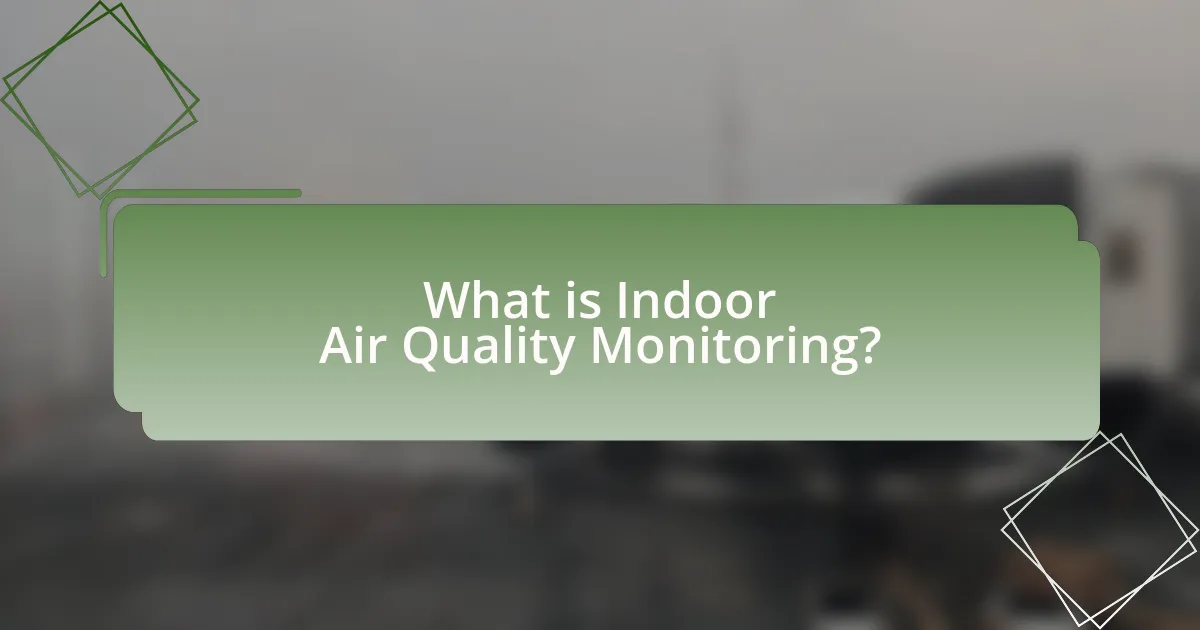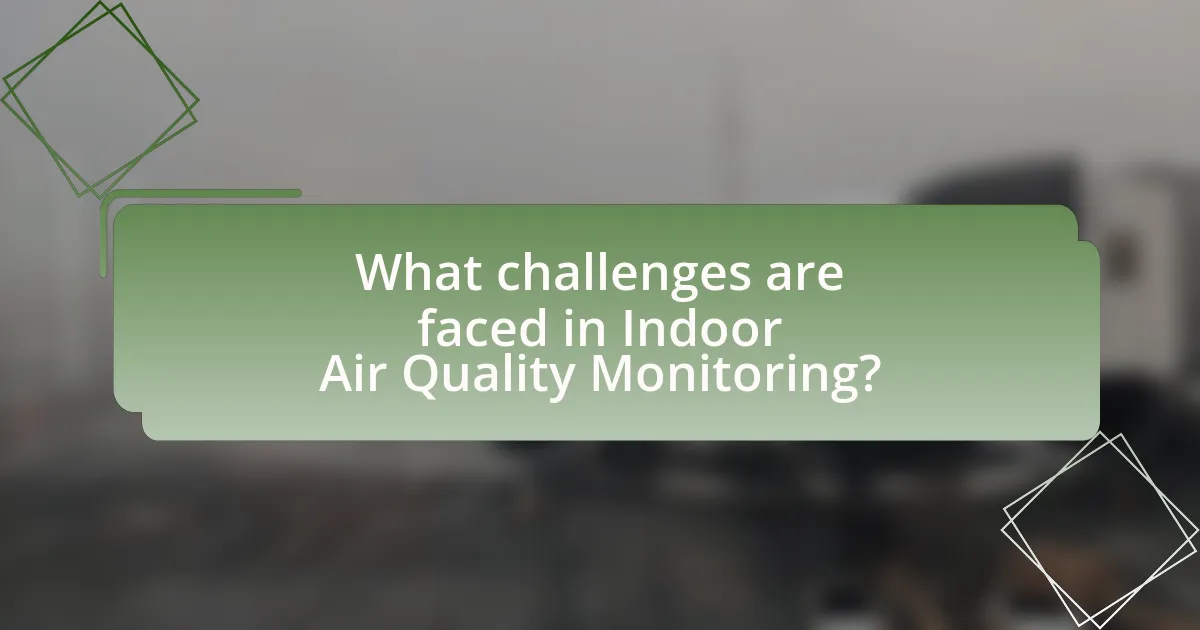Indoor Air Quality Monitoring is the systematic assessment of pollutants and environmental factors affecting indoor air quality, crucial for maintaining health and safety in various settings. The article explores the mechanisms of indoor air quality monitoring, including the role of sensors, key components of monitoring systems, and the importance of real-time data analysis. It highlights current trends such as the integration of smart technology and artificial intelligence, which enhance monitoring accuracy and efficiency. Additionally, the article addresses challenges in the field, including sensor limitations and data privacy concerns, while proposing strategies for effective monitoring and collaboration among stakeholders to improve indoor air quality management.
What is Indoor Air Quality Monitoring?

Indoor Air Quality Monitoring refers to the process of assessing and analyzing the levels of pollutants and other factors affecting the air quality within indoor environments. This monitoring typically involves measuring various parameters such as particulate matter, volatile organic compounds, carbon dioxide, humidity, and temperature to ensure a healthy and safe indoor atmosphere. Studies indicate that poor indoor air quality can lead to health issues, including respiratory problems and decreased cognitive function, highlighting the importance of effective monitoring systems in residential, commercial, and industrial settings.
How does Indoor Air Quality Monitoring work?
Indoor Air Quality Monitoring works by using sensors to detect and measure pollutants and environmental conditions within indoor spaces. These sensors analyze various parameters such as particulate matter, volatile organic compounds, carbon dioxide levels, humidity, and temperature. The data collected is then transmitted to a central system for analysis, allowing for real-time monitoring and assessment of air quality. Studies show that poor indoor air quality can lead to health issues, making effective monitoring essential for maintaining a safe environment.
What are the key components of Indoor Air Quality Monitoring systems?
The key components of Indoor Air Quality Monitoring systems include sensors, data processing units, communication interfaces, and user interfaces. Sensors detect various pollutants such as particulate matter, volatile organic compounds, carbon dioxide, and humidity levels. Data processing units analyze the information collected by the sensors to assess air quality. Communication interfaces transmit data to external systems or cloud platforms for further analysis and monitoring. User interfaces, such as mobile apps or dashboards, provide real-time information and alerts to users, enabling them to take necessary actions based on the air quality data.
How do sensors contribute to Indoor Air Quality Monitoring?
Sensors play a crucial role in Indoor Air Quality (IAQ) monitoring by providing real-time data on various air quality parameters such as particulate matter, volatile organic compounds, carbon dioxide, and humidity levels. These devices enable continuous assessment of indoor environments, allowing for timely detection of pollutants and potential health risks. For instance, studies have shown that the integration of sensors in smart building systems can lead to a 20% reduction in energy costs while improving occupant health and productivity by maintaining optimal air quality levels.
Why is Indoor Air Quality Monitoring important?
Indoor Air Quality Monitoring is important because it directly impacts health, productivity, and overall well-being. Poor indoor air quality can lead to respiratory issues, allergies, and other health problems, with studies indicating that indoor air can be up to five times more polluted than outdoor air. Monitoring allows for the detection of harmful pollutants, enabling timely interventions to improve air quality and reduce health risks. Furthermore, maintaining good indoor air quality has been shown to enhance cognitive function and productivity, making it crucial for workplaces and educational settings.
What health impacts are associated with poor indoor air quality?
Poor indoor air quality can lead to a range of health impacts, including respiratory issues, cardiovascular diseases, and exacerbation of allergies and asthma. Research indicates that exposure to indoor pollutants, such as volatile organic compounds and particulate matter, can significantly increase the risk of developing these health conditions. For instance, the World Health Organization has reported that indoor air pollution is responsible for approximately 3.8 million premature deaths annually, primarily due to respiratory infections and chronic obstructive pulmonary disease. Additionally, studies have shown that poor indoor air quality can impair cognitive function and overall well-being, further emphasizing the importance of maintaining healthy indoor environments.
How does Indoor Air Quality Monitoring enhance building safety?
Indoor Air Quality Monitoring enhances building safety by detecting harmful pollutants and ensuring compliance with health standards. By continuously measuring levels of volatile organic compounds, particulate matter, and carbon dioxide, these systems provide real-time data that can trigger alerts when air quality deteriorates. Research indicates that poor indoor air quality can lead to health issues such as respiratory problems and decreased cognitive function, which underscores the importance of monitoring. For instance, a study published in the journal “Environmental Health Perspectives” found that improved indoor air quality can reduce sick building syndrome symptoms by up to 30%. Thus, effective monitoring not only protects occupant health but also contributes to overall building safety.
What are the current trends in Indoor Air Quality Monitoring?
Current trends in Indoor Air Quality Monitoring include the integration of smart technology, real-time data analytics, and increased focus on health impacts. Smart sensors are being utilized to provide continuous monitoring of pollutants such as particulate matter, volatile organic compounds, and carbon dioxide levels. Real-time data analytics enable immediate responses to air quality changes, enhancing indoor environments. Furthermore, there is a growing emphasis on the health implications of indoor air quality, driven by research linking poor air quality to respiratory issues and other health problems, which has led to increased regulatory scrutiny and consumer awareness.
How is technology shaping the future of Indoor Air Quality Monitoring?
Technology is significantly shaping the future of Indoor Air Quality (IAQ) monitoring through advancements in sensor technology, data analytics, and integration with smart building systems. Modern sensors are becoming more affordable and accurate, allowing for real-time monitoring of pollutants such as volatile organic compounds (VOCs), particulate matter, and carbon dioxide levels. For instance, the use of low-cost, high-precision sensors enables continuous data collection, which can be analyzed to identify trends and sources of indoor air pollution.
Moreover, the integration of Internet of Things (IoT) technology allows these sensors to communicate with other building management systems, facilitating automated responses to poor air quality conditions. Research indicates that smart ventilation systems can adjust airflow based on real-time IAQ data, improving overall indoor environments and occupant health. A study published in the journal “Building and Environment” highlights that implementing smart IAQ monitoring systems can lead to a 20% reduction in energy costs while enhancing air quality.
These technological advancements not only enhance the accuracy and efficiency of IAQ monitoring but also empower building managers and occupants to make informed decisions regarding their indoor environments.
What role do smart homes play in Indoor Air Quality Monitoring?
Smart homes play a crucial role in indoor air quality monitoring by utilizing advanced sensors and automation technologies to continuously assess and manage air quality levels. These systems can detect pollutants, humidity, and temperature changes, providing real-time data to homeowners. For instance, smart air quality monitors can identify harmful substances like volatile organic compounds (VOCs) and particulate matter, enabling timely interventions such as activating air purifiers or adjusting ventilation systems. Research indicates that homes equipped with smart technology can reduce indoor air pollution by up to 50%, significantly improving overall health and comfort for occupants.
What innovations are emerging in Indoor Air Quality Monitoring?

Emerging innovations in Indoor Air Quality Monitoring include the use of advanced sensors, artificial intelligence, and real-time data analytics. Advanced sensors, such as low-cost IoT devices, enable continuous monitoring of pollutants like particulate matter, volatile organic compounds, and carbon dioxide levels. Artificial intelligence enhances data interpretation, allowing for predictive analytics that can forecast air quality trends and suggest corrective actions. Real-time data analytics platforms provide users with immediate feedback and actionable insights, improving indoor environments. These innovations are supported by research indicating that smart monitoring systems can significantly reduce indoor air pollution and enhance occupant health and productivity.
How are artificial intelligence and machine learning being utilized?
Artificial intelligence and machine learning are utilized in indoor air quality monitoring to analyze data from various sensors and predict air quality levels. These technologies enable real-time monitoring and assessment of pollutants, humidity, and temperature, allowing for timely interventions. For instance, machine learning algorithms can identify patterns in air quality data, leading to improved ventilation strategies and energy efficiency in buildings. Studies have shown that AI-driven systems can reduce energy consumption by up to 30% while maintaining optimal air quality, demonstrating their effectiveness in enhancing indoor environments.
What benefits do AI-driven systems provide for Indoor Air Quality Monitoring?
AI-driven systems enhance Indoor Air Quality Monitoring by providing real-time data analysis and predictive insights. These systems utilize machine learning algorithms to process vast amounts of environmental data, enabling the identification of pollutants and their sources more accurately than traditional methods. For instance, a study published in the journal “Environmental Science & Technology” demonstrated that AI models could predict air quality fluctuations with up to 90% accuracy, significantly improving response times to air quality issues. Additionally, AI-driven systems can automate ventilation controls based on real-time air quality data, optimizing energy use while ensuring healthier indoor environments.
How can machine learning improve data analysis in Indoor Air Quality Monitoring?
Machine learning can significantly enhance data analysis in Indoor Air Quality Monitoring by enabling the identification of complex patterns and anomalies in large datasets. This technology utilizes algorithms that can process and analyze vast amounts of sensor data in real-time, allowing for more accurate predictions of air quality levels and the detection of pollutants. For instance, studies have shown that machine learning models can achieve over 90% accuracy in predicting indoor air quality parameters by learning from historical data and environmental factors. This capability not only improves the reliability of monitoring systems but also facilitates proactive measures to mitigate air quality issues, ultimately leading to healthier indoor environments.
What advancements are being made in sensor technology?
Advancements in sensor technology include the development of miniaturized sensors that enhance indoor air quality monitoring. These sensors are increasingly capable of detecting a wider range of pollutants, such as volatile organic compounds (VOCs), particulate matter, and carbon dioxide, with higher accuracy and faster response times. For instance, recent innovations have led to the integration of IoT capabilities, allowing real-time data transmission and remote monitoring through mobile applications. Additionally, advancements in materials science have enabled the creation of more sensitive and selective sensors, improving their performance in diverse environmental conditions. These developments are supported by research indicating that smart sensors can significantly improve air quality management in indoor spaces, as evidenced by studies published in journals like Environmental Science & Technology.
What types of sensors are becoming more prevalent in Indoor Air Quality Monitoring?
Various types of sensors are becoming more prevalent in Indoor Air Quality Monitoring, including particulate matter sensors, volatile organic compound (VOC) sensors, carbon dioxide (CO2) sensors, and humidity sensors. Particulate matter sensors measure airborne particles, which are critical for assessing health risks associated with air pollution. VOC sensors detect harmful chemicals that can off-gas from building materials and furnishings, contributing to indoor air toxicity. CO2 sensors monitor levels of carbon dioxide, which can indicate ventilation effectiveness and occupant density. Humidity sensors help maintain optimal moisture levels, preventing mold growth and ensuring comfort. The increasing focus on health and environmental standards drives the adoption of these sensors in various settings, including residential, commercial, and industrial environments.
How do new sensor technologies improve accuracy and reliability?
New sensor technologies enhance accuracy and reliability by utilizing advanced materials and algorithms that improve data collection and processing. For instance, sensors equipped with microelectromechanical systems (MEMS) can detect minute changes in air quality with high precision, reducing the margin of error in measurements. Additionally, the integration of machine learning algorithms allows for real-time data analysis, enabling sensors to adapt to varying environmental conditions and filter out noise, which further increases reliability. Research indicates that these technologies can achieve up to 95% accuracy in detecting pollutants, significantly outperforming traditional sensors that often have an accuracy rate below 70%.
What challenges are faced in Indoor Air Quality Monitoring?

Indoor Air Quality Monitoring faces several challenges, including sensor accuracy, data interpretation, and environmental variability. Sensor accuracy is critical, as unreliable readings can lead to incorrect assessments of air quality; for instance, studies have shown that low-cost sensors often struggle with precision compared to reference-grade instruments. Data interpretation poses another challenge, as the complexity of indoor environments requires sophisticated algorithms to analyze and contextualize the data effectively. Additionally, environmental variability, such as changes in occupancy and activity levels, can significantly impact air quality, making it difficult to establish consistent monitoring protocols. These challenges highlight the need for advancements in technology and methodologies to improve Indoor Air Quality Monitoring.
What are the limitations of current Indoor Air Quality Monitoring systems?
Current Indoor Air Quality Monitoring systems face several limitations, including inadequate sensor accuracy, limited pollutant detection range, and high costs. Many existing sensors struggle to provide precise measurements for specific pollutants, leading to unreliable data. For instance, common sensors may not effectively detect volatile organic compounds (VOCs) or particulate matter at low concentrations, which are critical for assessing air quality. Additionally, the high cost of advanced monitoring systems can restrict their accessibility for widespread use in residential settings. According to a study published in the journal “Environmental Science & Technology,” many low-cost sensors exhibit significant variability in performance, which further complicates their reliability in real-world applications.
How can data privacy concerns affect Indoor Air Quality Monitoring?
Data privacy concerns can significantly hinder the effectiveness of Indoor Air Quality (IAQ) monitoring by limiting the data collection and sharing necessary for accurate assessments. When individuals are apprehensive about how their personal data is used, they may refuse to participate in monitoring programs or opt out of sharing data, which reduces the overall data pool. This lack of comprehensive data can lead to less reliable insights into air quality conditions, ultimately affecting public health initiatives and regulatory compliance. For instance, a study by the International Journal of Environmental Research and Public Health highlights that privacy concerns can lead to decreased user engagement with smart monitoring technologies, which are essential for real-time IAQ assessments.
What are the barriers to widespread adoption of Indoor Air Quality Monitoring technologies?
The barriers to widespread adoption of Indoor Air Quality Monitoring technologies include high costs, lack of awareness, and insufficient regulatory support. High costs deter many potential users, as advanced monitoring systems can be expensive to purchase and maintain. Lack of awareness among consumers and businesses about the importance of indoor air quality contributes to low demand for these technologies. Additionally, insufficient regulatory support means there are few incentives or requirements for implementing monitoring systems, which further hinders adoption. According to a study by the Environmental Protection Agency, only 20% of buildings in the U.S. have adequate air quality monitoring, highlighting the need for increased awareness and regulatory frameworks to promote these technologies.
How can these challenges be addressed?
To address the challenges of indoor air quality monitoring, implementing advanced sensor technologies and data analytics is essential. These technologies can provide real-time monitoring and accurate data collection, enabling timely interventions. For instance, the integration of IoT devices allows for continuous tracking of air quality parameters, while machine learning algorithms can analyze the data to identify patterns and predict potential air quality issues. Research by the Environmental Protection Agency indicates that improved monitoring can lead to a 30% reduction in indoor air pollutants, demonstrating the effectiveness of these approaches.
What strategies can improve the effectiveness of Indoor Air Quality Monitoring?
Implementing real-time data analytics significantly enhances the effectiveness of Indoor Air Quality Monitoring. By utilizing advanced algorithms and machine learning techniques, systems can analyze air quality data continuously, allowing for immediate detection of pollutants and anomalies. Research indicates that real-time monitoring can reduce indoor air pollution levels by up to 50% when combined with automated ventilation systems, as demonstrated in a study published in the Journal of Environmental Management. Additionally, integrating user-friendly interfaces and mobile applications facilitates better engagement and responsiveness from occupants, further improving air quality outcomes.
How can collaboration among stakeholders enhance Indoor Air Quality Monitoring efforts?
Collaboration among stakeholders can significantly enhance Indoor Air Quality Monitoring efforts by pooling resources, expertise, and data-sharing capabilities. When various stakeholders, such as government agencies, private companies, and community organizations, work together, they can develop comprehensive monitoring systems that utilize advanced technologies and methodologies. For instance, a study by the World Health Organization indicates that collaborative approaches can lead to improved data accuracy and more effective interventions, as stakeholders can leverage each other’s strengths and insights. This collective effort not only fosters a more holistic understanding of indoor air quality issues but also promotes the implementation of best practices and innovative solutions tailored to specific environments.
What best practices should be followed for effective Indoor Air Quality Monitoring?
Effective Indoor Air Quality Monitoring requires the implementation of continuous monitoring systems, regular maintenance of equipment, and the use of multiple sensors to capture a range of pollutants. Continuous monitoring systems provide real-time data, allowing for immediate responses to changes in air quality. Regular maintenance ensures that sensors remain accurate and functional, which is critical for reliable data collection. Utilizing multiple sensors, such as those for particulate matter, volatile organic compounds, and carbon dioxide, enables a comprehensive assessment of indoor air quality. Research indicates that buildings with effective monitoring systems can reduce indoor air pollutants by up to 50%, significantly improving occupant health and comfort.
How can regular maintenance improve Indoor Air Quality Monitoring systems?
Regular maintenance enhances Indoor Air Quality Monitoring systems by ensuring their accuracy and reliability. Consistent upkeep, such as calibrating sensors and replacing filters, prevents data drift and sensor degradation, which can lead to incorrect readings. For instance, a study published in the Journal of Environmental Monitoring found that poorly maintained sensors can exhibit a 30% error rate in pollutant detection. By implementing regular maintenance schedules, organizations can significantly improve the performance and longevity of these systems, ultimately leading to better indoor air quality management.
What are the key metrics to track for optimal Indoor Air Quality Monitoring?
The key metrics to track for optimal Indoor Air Quality Monitoring include particulate matter (PM2.5 and PM10), volatile organic compounds (VOCs), carbon dioxide (CO2) levels, humidity, and temperature. Particulate matter levels indicate the presence of airborne pollutants, with PM2.5 being particularly harmful to health, as studies show that exposure can lead to respiratory issues and cardiovascular diseases. VOCs, which are emitted from various household products, can contribute to indoor air pollution and affect health, making their monitoring essential. Elevated CO2 levels can indicate poor ventilation, which can lead to discomfort and cognitive impairment, as research has shown that high CO2 concentrations can negatively impact decision-making abilities. Humidity levels are crucial as they affect comfort and can promote mold growth if too high, while low humidity can lead to respiratory problems. Temperature also plays a role in comfort and can influence the effectiveness of ventilation systems. Monitoring these metrics provides a comprehensive understanding of indoor air quality and helps in maintaining a healthy environment.

Leave a Reply